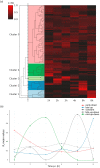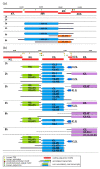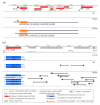Time-Course Transcriptome Profiling of a Poxvirus Using Long-Read Full-Length Assay
- PMID: 34451383
- PMCID: PMC8398953
- DOI: 10.3390/pathogens10080919
Time-Course Transcriptome Profiling of a Poxvirus Using Long-Read Full-Length Assay
Abstract
Viral transcriptomes that are determined using first- and second-generation sequencing techniques are incomplete. Due to the short read length, these methods are inefficient or fail to distinguish between transcript isoforms, polycistronic RNAs, and transcriptional overlaps and readthroughs. Additionally, these approaches are insensitive for the identification of splice and transcriptional start sites (TSSs) and, in most cases, transcriptional end sites (TESs), especially in transcript isoforms with varying transcript ends, and in multi-spliced transcripts. Long-read sequencing is able to read full-length nucleic acids and can therefore be used to assemble complete transcriptome atlases. Although vaccinia virus (VACV) does not produce spliced RNAs, its transcriptome has a high diversity of TSSs and TESs, and a high degree of polycistronism that leads to enormous complexity. We applied single-molecule, real-time, and nanopore-based sequencing methods to investigate the time-lapse transcriptome patterns of VACV gene expression.
Keywords: gene expression; long-read sequencing; nanopore sequencing; transcriptome profiling; vaccinia virus.
Conflict of interest statement
The authors declare no conflict of interest.
Figures






Similar articles
-
Time-course transcriptome analysis of host cell response to poxvirus infection using a dual long-read sequencing approach.BMC Res Notes. 2021 Jun 24;14(1):239. doi: 10.1186/s13104-021-05657-x. BMC Res Notes. 2021. PMID: 34167576 Free PMC article.
-
Long-read sequencing uncovers a complex transcriptome topology in varicella zoster virus.BMC Genomics. 2018 Dec 4;19(1):873. doi: 10.1186/s12864-018-5267-8. BMC Genomics. 2018. PMID: 30514211 Free PMC article.
-
Long-read assays shed new light on the transcriptome complexity of a viral pathogen.Sci Rep. 2020 Aug 14;10(1):13822. doi: 10.1038/s41598-020-70794-5. Sci Rep. 2020. PMID: 32796917 Free PMC article.
-
Long-Read Sequencing - A Powerful Tool in Viral Transcriptome Research.Trends Microbiol. 2019 Jul;27(7):578-592. doi: 10.1016/j.tim.2019.01.010. Epub 2019 Feb 26. Trends Microbiol. 2019. PMID: 30824172 Review.
-
Methodologies for Transcript Profiling Using Long-Read Technologies.Front Genet. 2020 Jul 7;11:606. doi: 10.3389/fgene.2020.00606. eCollection 2020. Front Genet. 2020. PMID: 32733532 Free PMC article. Review.
Cited by
-
Hybrid sequencing discloses unique aspects of the transcriptomic architecture in equid alphaherpesvirus 1.Heliyon. 2023 Jun 28;9(7):e17716. doi: 10.1016/j.heliyon.2023.e17716. eCollection 2023 Jul. Heliyon. 2023. PMID: 37449092 Free PMC article.
-
Exploring the transcriptomic profile of human monkeypox virus via CAGE and native RNA sequencing approaches.mSphere. 2024 Sep 25;9(9):e0035624. doi: 10.1128/msphere.00356-24. Epub 2024 Aug 27. mSphere. 2024. PMID: 39191390 Free PMC article.
-
Hepatitis B virus serum RNA transcript isoform composition and proportion in chronic hepatitis B patients by nanopore long-read sequencing.Front Microbiol. 2023 Aug 14;14:1233178. doi: 10.3389/fmicb.2023.1233178. eCollection 2023. Front Microbiol. 2023. PMID: 37645229 Free PMC article.
-
In-depth Temporal Transcriptome Profiling of Monkeypox and Host Cells using Nanopore Sequencing.Sci Data. 2023 May 9;10(1):262. doi: 10.1038/s41597-023-02149-4. Sci Data. 2023. PMID: 37160911 Free PMC article.
References
-
- Moss B. Poxviridae. In: Knipe B.M., Howley P.M., Cohen J.I., Griffin D.E., Lamb R.A., Martin M.A., Rancaniello V.R., Roizman B., editors. Fields Virology. 6th ed. Volume 2. Lippincott Williams & Wilkins; Philadelphia, PA, USA: 2013. pp. 2129–2159.
Grants and funding
LinkOut - more resources
Full Text Sources

